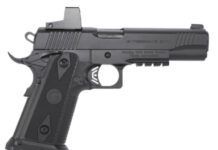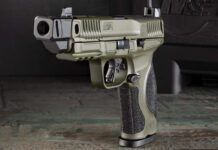More than 100 years ago, Georg Luger took the Borchardt pistol and redesigned it into one of the most famous military handguns of all time. While other handguns may have been better suited for warfare, none were better made of better material. Luger took the original pistol and changed the recoil spring, magazine, grip angle, barrel and even the caliber. But he kept the distinctive toggle action. The original toggle, we believe, was developed by Oliver Henry to give excellent leverage and operation in his Henry rifle, which later evolved into the Winchester ’66. Maxim took the toggle action and adopted it to his first machinegun. It was only natural Borchardt and then Luger took the toggle action and adopted it to a self-loading handgun. The original Luger was chambered for the 30 Luger cartridge, just another of the many 30-caliber pistol rounds current at the turn of the previous century. But when the German Navy and later the Army demanded more smash, Luger developed the 9mm Luger cartridge. The 9mm Parabellum, aka 9mm Luger cartridge as it is variously known, was an immediate sensation.
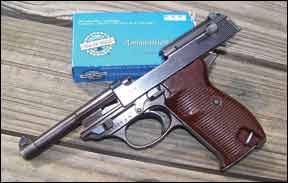
The virtues of the 9mm Luger cartridge are many. The round is compact for the power compared to the 9mm Steyr, 9mm Largo, and other cartridges, and much more powerful than similar-sized revolver cartridges of the day. The 9mm has sufficient power for service use and may prove deadly well beyond normal pistol range. It was among the first handgun cartridges with good penetration against web gear. This immensely popular cartridge eventually became the most popular military handgun cartridge of all time.
The Luger pistol and the Luger cartridge are inseparable, but it was only a matter of time until other handguns were developed using the 9mm cartridge. After World War I there were many such developments. Among the most successful was the Browning High Power. The High Power, or P 35, as it is variously known, was a single-action locked-breech design with a high-capacity magazine. The 13-shot Browning was arguably the first of the Wonder Nine handguns. The High Power saw use during World War II by both sides. The John Inglis-produced variant is still in service with our Canadian allies in Afghanistan, and the Belgian High Power is in use with Allied forces in Iraq. The High Power at one time armed the soldiers of some 100 nations. The pistol has been revered by combat shooters for nearly 75 years. The High Power runs a close second to the 1911 in the hearts and minds of those who favor the single-action pistol.
If the High Power was successful, the Walther P-38 was influential. The P-38 was adopted as the standard handgun of the German Army in 1938, about three years after the introduction of the High Power. The P-38 features a double-action first shot, a slide-mounted decocker, an open-top slide, and other modern features. It is interesting to note that the three 9mm pistols we are firing in this shoot-out all use a different locking system. The Luger uses the toggle lock, the High Power uses angled camming surfaces, and the P-38 uses the oscillating wedge first used in the Mauser C 96 pistol. While the toggle lock is far too expensive for effective modern manufacture, the other types of lock-up remain popular.
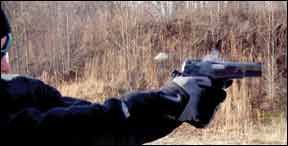
The High Power was very successful, but the P-38, produced in smaller numbers, was more influential. The double-action first-shot feature made quite an impression on the Allies. The Walther was designed to be cost-effective in manufacture compared to the expensive Luger pistol, and the Luger was discontinued from manufacture in 1942. Just the same, the P-38 was well made of good material. Our current service pistol, the Beretta 92, is in most ways an updated P-38. The drawbar and action are the same, the open-top slide is similar, and the safety/decock lever is practically identical. The safety lever of the P-38 is easier to use quickly. The Beretta features a double-column magazine, but that does not necessarily make the pistol more effective. For some hand sizes, the high-capacity pistol is less steady.
We enjoy a good read and historical research. We are also interested in how the pistols shoot, and for that information we like to shoot them ourselves. These pistols are from the collection of one of our raters. He thinks that they are the three most important 9mm pistols of World War II. The Polish Radom was also considered for this test because it is well made, reliable, accurate and as fine a gun as any, according to our rater who also owns the Radom, but the Radom was neither successful commercially nor particularly influential. Its niche is as the last cavalry pistol. We also have on hand modern High Power pistols such as the Practical Model and also modern variants of the Walther P-38. The aluminum-frame P 1 addressed the weight issue of the original pistol and also solved some problems with the slide and slide cracking. The P 1 features a noticeable slide redesign and a strengthening pin in the frame. But these are not World War II variants.
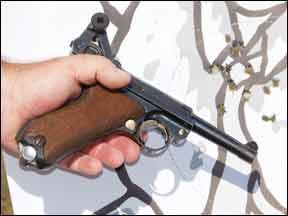
So we went forward with three WWII pistols head to head, listing their actual purchase prices from the owner: a John Inglis High Power 9mm Luger, $650; a Luger P-08 9mm Luger, $940; and a Walther P-38 9mm, $800. We used new production 9mm Luger ball ammunition during the initial evaluation, from Black Hills Ammunition. We planned on using ball ammunition for firing impressions and broadening the ammunition selection during the accuracy testing. Attempting to find loads that would function in the Luger sidelined us for some time. During the test period we fired several Luger pistols and also a second P-38, but ran start to finish with the same High Power. After all, we were looking for impressions of the breed. Our rater was embarrassed that his rather nice Luger was not as reliable as some of the other Lugers fired on the side. Another Luger in his collection has fired more than 2500 rounds of modern Fiocchi ball and JSP loads without a hitch, but it did not quality for the test because it is a 30 Luger commercial pistol. Let’s look at each pistol and see what the raters thought.
Walther P-38 9mm, $800
This handgun proved surprising to those who have never fired the Walther. While the double-action first shot is heavier than modern shooters are used to—and heavier than a P 1 we had on hand for comparison—the P-38 was a good shooter. We were surprised Walther used a heel-based magazine catch, because the Luger, a much earlier handgun, featured a pushbutton release. We think it had something to do with the German’s idea of magazine retention. In single-action fire, the pistol was quite accurate. The Walther never failed to feed, chamber, fire, or eject. We used ball ammunition, primarily for economy, but the Walther never failed to feed a modest mix of hollowpoints. We sacrificed a few of the new Ranger T LEO +P and +P+ loads from Winchester and found function and accuracy were good, and the steel-frame pistol was very comfortable to fire. Don’t frown—original German military ammunition was probably at least as hot as these loads.
Those who preferred a double-action first shot pistol naturally preferred the Walther, and the Beretta fan among the raters grudgingly admitted that the Walther’s long safety lever was much easier to manipulate quickly than the Beretta 92. However, the long lever might not work well with a fat receiver designed for a high-capacity magazine. Despite the age of the pistol, the raters had to admit the pistol is a viable defense and service pistol today. In fact the Walther is superior, we thought, to quite a few later service pistols including the Beretta 951, the French M 50 and the poorly made Helwan. All of these were single-column magazine pistols. The Smith & Wesson Model 39 is basically an Americanized Walther P-38, but none of our raters familiar with both pistols thought the M39 held a candle to the Walther.
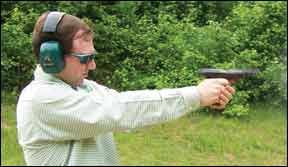
The consensus was, if we were going to outfit an army, we would buy the High Power. For personal protection, some of the raters preferred the double-action Walther. The handfit with the single-column magazine is superior for most hand sizes. We expected the Luger to be the most accurate pistol, but it was not. The Walther P-38 turned in the tightest groups, largely due to a decent single-action trigger and excellent sights. The Walther’s takedown, by means of a simple lever, was rated high. The dual recoil springs were considered eccentric, but they worked.
Our Team Said: Although the High Power is by far the more popular handgun, the P-38 gave us pause. It is a better performer than most of us realized. After all, most interested handgunners have fired some type of High Power, but few have fired an original P-38 in such fine condition. The P-38 was rumored to crack slides, and one of our raters produced a 1945 version with one repaired crack and another incipient crack.
John Inglis High Power 9mm Luger, $650
This is a High Power of the type used by China and other Allies during World War II. The pistol is a straightforward Browning design. The trigger was surprisingly good, possibly because the pistol was either produced without the magazine safety or someone removed it long ago. This pistol is finished in a black phosphate that only the gun’s mother could love.
The High Power features well-placed controls. The much criticized small safety is not that difficult to manipulate with practice, so cocked-and-locked carry would be viable. The tangent rear sights give an excellent sight picture coupled with the square front post. The front post is a dovetail type adjustable for windage.
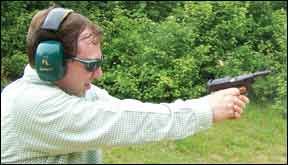
All raters enjoyed firing the High Power, and firing was made easier by six spare magazines supplied by the owner. Of various states of wear and finish, none malfunctioned. The bottom line with this handgun was reliability. The Inglis 9mm never failed to feed, chamber, fire, or eject with any type of ammunition. Ball, lead flatpoint, or jacketed hollow point, slightly below standard velocity or +P, the High Power fed them all despite the warnings of some. We think that first generation hollowpoint bullets were poorly designed, and that is why the High Power did not feed them.
Our Team Said: The High Power received high ratings for accuracy, control, reliability, and even flatness in concealed carry. Each and every rater was firm in the opinion that he or she would carry the High Power anywhere in confidence. A minor drawback is that this military handgun features a lanyard ring that prevents fitting modern custom grips or Pachmayrs. The original grips are serviceable, but homely. In the end, the opinion of the Gun Tests raters is that the Browning High Power is the greatest 9mm service pistol to date. After all, it is the only one of the handguns tested still serving on the front line and still in production, and that is quite a story in itself.
Luger P-08 9mm Luger, $940
The Luger is surprisingly modern in some regards, with a push-button magazine release and handy takedown lever. The pistol’s balance is practically perfect—the weight is balanced over the hand, the Luger points like a finger, the pistol is light enough, and the trigger far better than most would have us believe. The safety is impossible for speed shooting. The toggle is not particularly easy to cock quickly. The sights are more or less OK, a trapezoid-type front post in an inverted V rear notch. The feature everyone loved was the 110-degree grip angle. This may be the most comfortable grip angle ever devised. The problem was getting the pistol to shoot well. The whole story would make two reports, but suffice to say the pistol did not function with anything we tried at first. We even tried Winchester’s 124-grain NATO load. We would get almost a magazine and then a failure of the toggle to completely close.
We replaced the springs with WC Wolff premium gun springs (www.Brownells.com) and obtained a new magazine from Triple K manufacturing. We resorted to firing Black Hills +P loads and even a magazine full of the Buffalo Bore +P+, pretty pricey to fire in an old military pistol for a function test. Each did well, but no matter what we used, the Luger never functioned at 100%. (The Luger feeds hollowpoint bullets without complaint, it is cycle, not feed reliability, that is the problem.) One of our raters is an enthusiastic handloader and he finally worked up an effective and affordable combination of the Hornady 124-grain XTP and enough WW 231 to break about 1250 fps to 1350 fps to obtain good function. This is really too hot, but the Luger stepped up to about 75% reliability.
Our Team Said: We had hoped to have a good time firing this pistol and hoped to enjoy good function during accuracy testing. As it was, the test was a bust, although we did obtain decent accuracy results. We occasionally had to slap the toggle shut. According to other shooters, this is a common problem with the German Luger. The Luger is simply a collector’s gun today. We cannot recommend the Luger as a recreational shooter due to the aggravation of simply getting some examples to run.
0611-MILITARY-9MMS-ACC-CHRONO.pdf

























